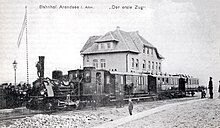Stendal – Arendsee railway line
| Stendal – Arendsee | |||||||||||||||||||||||||||||||||||||||||||||||||||||||||||||||||||||||||||||||||||||||||||||||||||||||||||||||||||||||||
|---|---|---|---|---|---|---|---|---|---|---|---|---|---|---|---|---|---|---|---|---|---|---|---|---|---|---|---|---|---|---|---|---|---|---|---|---|---|---|---|---|---|---|---|---|---|---|---|---|---|---|---|---|---|---|---|---|---|---|---|---|---|---|---|---|---|---|---|---|---|---|---|---|---|---|---|---|---|---|---|---|---|---|---|---|---|---|---|---|---|---|---|---|---|---|---|---|---|---|---|---|---|---|---|---|---|---|---|---|---|---|---|---|---|---|---|---|---|---|---|---|---|
| Route number : | 6897 Stendal Ost – Arendsee 6895 Stendal Vorbf. – Stendal Ost |
||||||||||||||||||||||||||||||||||||||||||||||||||||||||||||||||||||||||||||||||||||||||||||||||||||||||||||||||||||||||
| Course book range : | 754 (1979) | ||||||||||||||||||||||||||||||||||||||||||||||||||||||||||||||||||||||||||||||||||||||||||||||||||||||||||||||||||||||||
| Route length: | 49.3 km | ||||||||||||||||||||||||||||||||||||||||||||||||||||||||||||||||||||||||||||||||||||||||||||||||||||||||||||||||||||||||
| Gauge : | 1435 mm ( standard gauge ) | ||||||||||||||||||||||||||||||||||||||||||||||||||||||||||||||||||||||||||||||||||||||||||||||||||||||||||||||||||||||||
|
|||||||||||||||||||||||||||||||||||||||||||||||||||||||||||||||||||||||||||||||||||||||||||||||||||||||||||||||||||||||||
The Stendal – Arendsee railway was a standard gauge small railway in the Altmark. The 49-kilometer route began at the state train station in Stendal and led via the Ostbahnhof in a north-westerly direction via Peulingen and Klein Rossau to Arendsee . It was opened in 1908 and operated by Kleinbahn AG Stendal – Arendsee , which later merged with the Arneburg line to form the Stendaler Kleinbahn . Passenger traffic was phased out in 1978 and 1979 and freight traffic in 1985.
history
Around 1900 efforts arose to connect the area between the two state railway lines Stendal – Uelzen and Stendal – Wittenberge to the railway. This project was favored by the Prussian Kleinbahngesetz from 1892. On March 22, 1906, Kleinbahn AG Stendal – Arendsee was founded. The Kingdom of Prussia and the Province of Saxony each took over 23 percent of the shares. The remaining capital, which at over two million marks was almost five times as high as, for example, when the neighboring Arneburg small railway was built, was divided between the city and district of Stendal, the city of Arendsee and numerous entrepreneurs and other interested parties.
On November 25, 1908, the line was first opened to Lückstedt - Dewitz and finally to Arendsee on December 8 of the same year. Until the opening of the Salzwedel – Geestgottberg railway in 1922, the Kleinbahn was operationally a branch line .
In 1913 a total of 159,000 passengers were recorded. In freight transport, the transport performance was spread across 56,617 tons of agricultural products, 16,756 tons of feed and fertilizers , 11,126 live animals and over 97,000 other goods.
Klein Rossau was converted into a crossing station in 1914 as part of the opening of the Kleinbahn-AG Osterburg – Deutsch Pretzier . The level threading of the east-west connection south of Klein Rossau enabled continuous train connections between Osterburg and Arendsee. In 1928, for example, in addition to three to four pairs of trains from Stendal to Arendsee, another pair of trains was offered on the route from Osterburg to Klein Rossau to Arendsee.
In the same year, a siding was built from the Stendal Ost station to the “Sächsische Eisenbahnbedarfs- und Maschinenfabrik Sachsenwerk GmbH”, later part of the Stendal Reichsbahn repair workshop .
On November 23, 1915, the operating company changed its name to Stendaler Kleinbahn AG and merged with Kleinbahn-AG Stendal-Arneburg . The joint fleet of cars on both lines included steam locomotives of the types Bn2t, Cn2t and 1'Cn2t manufactured by Henschel .
During the Second World War , two more trains in each direction between Stendal and Borstel were used in addition to the four regular pairs of trains in order to better connect the Stendal-Borstel military airfield .
After the end of the war, the Sächsische Provinzbahnen GmbH took over the operation at the end of 1946 , from August 15, 1948 the Association of Publicly Owned Enterprises (VVB) of the Saxony-Anhalt transport system and finally, from April 1, 1949, the Deutsche Reichsbahn . In the last years of operation, class 102 diesel locomotives with four-axle wagons took over the services between Stendal and Arendsee.
Due to increasingly better developed roads, the small railroad lost its importance. The driving time of more than two hours was partly responsible for this, which corresponds to an average speed of only 24 km / h. Freight traffic between Klein Rossau and Arendsee ended on May 31, 1970. Passenger traffic was discontinued on May 28, 1978 and on the Stendal – Klein Rossau section a year later on May 26, 1979. Freight traffic between Stendal and Klein Rossau lasted until June 2, 1985. However, until 1994/95 there were supposed to have been freight trains between Stendal Vorbahnhof and Stendal Ost and Borstel.
literature
- Wolfgang List: Kleinbahnen der Altmark . Transpress VEB publishing house for transport, Berlin 1979, DNB 800189620 . (Licensed edition: Alba, Düsseldorf 1979, ISBN 3-87094-528-1 )
- Wolfgang List: Stendal and the railroad. Volume 2: The small railways. Verlag Bernd Neddermeyer, Berlin 2008, ISBN 978-3-933254-93-1 .
- Wolfgang List, Hans Röper, Gerhard Zieglgänsberger: Archives of German small and private railways. Saxony-Anhalt. (Routes, vehicles, operations). Transpress, Stuttgart 1998, ISBN 3-613-71087-0 .
- Klaus Kieper, Reiner Preuß: Narrow Gauge Railway Archive. 2nd Edition. Transpress - Publishing House for Transport, Berlin 1982, DNB 820820636 . (Reprinted as: GDR narrow-gauge railway archive. Transpress, Stuttgart 2011, ISBN 978-3-613-71405-2 )

